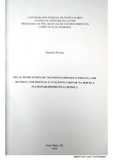| dc.creator | Prestes, Daniele | |
| dc.date.accessioned | 2021-11-19T14:47:38Z | |
| dc.date.available | 2021-11-19T14:47:38Z | |
| dc.date.issued | 2019-07-12 | |
| dc.identifier.uri | http://repositorio.ufsm.br/handle/1/22887 | |
| dc.description.abstract | Swallowing is a physiological action involving a great process of voluntary and involuntary
actions and its function is to conduct food from the oral cavity to the stomach in a safe way,
mainly to protect the airway. In addition, it requires the concise coordination of four essential
phases for the transit of the food bolus from the mouth to the stomach, beginning with the oral
and oral preparatory phase (voluntary) and later pharyngeal and esophageal phases
(involuntary), any change in one or more of these phases is defined as dysphagia. The
etiology of swallowing changes in Chronic Obstructive Pulmonary Disease (COPD) has not
yet been well established. In this context, assessing the different phases of swallowing along
with characteristic changes of COPD becomes important. Thus, the present research had as
objective to relate the pharyngeal transit time and the presence of residual in vallecula and
pyriform sinuses with dyspnea and pulmonary function in individuals with COPD. This is an
observational, descriptive and cross-sectional study with adult individuals, both sexes, with
clinical diagnosis performed by the pulmonologist and spirometric of COPD, referred to the
Pulmonary Rehabilitation Program by the Department of Pulmonology of the Hospital
Universitário de Santa Maria. The sample was submitted to the anthropometric evaluation, to
calculate the Body Mass Index (BMI), physical therapy evaluation, to characterize the impact
of the disease on the individual, dyspnea and lung function. The speech-language evaluation
was performed by videofluoroscopy of swallowing for analysis of the variables oral transit
time, pharyngeal transit time and pharyngeal residues. The exams were analyzed using
Kinovea® software by three blinded judges. We analyzed 19 individuals (11 males and 8
females), with a mean of 63.8 years and eutrophic. There was no relation regarding TTF
variables with pulmonary function and pharyngeal residue with dyspnea. TTF, when
compared with normal, was increased. We conclude that individuals with COPD, regardless
of the severity of the disease, did not show changes in TTF related deglutition and presence of
residuals in valleculae and pyriform sinuses. | eng |
| dc.description.sponsorship | Coordenação de Aperfeiçoamento de Pessoal de Nível Superior - CAPES | por |
| dc.language | por | por |
| dc.publisher | Universidade Federal de Santa Maria | por |
| dc.rights | Attribution-NonCommercial-NoDerivatives 4.0 International | * |
| dc.rights.uri | http://creativecommons.org/licenses/by-nc-nd/4.0/ | * |
| dc.subject | DPOC (Doença Pulmonar Obstrutiva Crônica) | por |
| dc.subject | Deglutição | por |
| dc.subject | Transtornos da deglutição | por |
| dc.subject | Deglutition | eng |
| dc.subject | COPD (Chronic Obstructive Pulmonary Disease) | eng |
| dc.subject | Deglutition disorders | eng |
| dc.title | Relação do tempo de trânsito faríngeo e presença de resíduo com dispneia e função pulmonar na doença pulmonar obstrutiva crônica | por |
| dc.title.alternative | Relationship of the pharyngeal time transition and residue with dysspnea and pulmonary function in chronic obstructive pulmonary disease | eng |
| dc.type | Dissertação | por |
| dc.description.resumo | A deglutição é uma ação fisiológica que envolve um grande processo de ações voluntárias e
involuntárias e sua função é conduzir o alimento da cavidade oral até o estômago de forma
segura, principalmente, para proteger a via aérea. Além disto, necessita da concisa
coordenação de quatro fases indispensáveis para o trânsito do bolo alimentar da boca até o
estômago, iniciando pela fase preparatória oral e oral (voluntárias) e posteriormente fases
faríngea e esofágica (involuntárias), qualquer alteração em uma ou mais destas fases é
definida como disfagia. A etiologia das alterações de deglutição na Doença Pulmonar
Obstrutiva Crônica (DPOC), ainda não estão bem estabelecidas. Neste contexto, avaliar as
diferentes fases da deglutição juntamente com alterações características da DPOC torna-se
importante. Desta forma, a presente pesquisa teve como objetivo relacionar o tempo de
trânsito faríngeo e a presença de resíduo em valécula e seios piriformes com a dispneia e a
função pulmonar em indivíduos com Doença Pulmonar Obstrutiva Crônica. Trata-se de um
estudo com delineamento observacional, descritivo e transversal com indivíduos adultos,
ambos os sexos, com diagnóstico clínico, realizado pelo pneumologista, e espirométrico de
DPOC, encaminhados ao Programa de Reabilitação Pulmonar pelo Serviço de pneumologia
do Hospital Universitário de Santa Maria. A amostra foi submetida à avaliação
antropométrica, para o cálculo do Índice de Massa Corporal (IMC), avaliação fisioterapêutica,
para caracterizar o impacto da doença no indivíduo, a dispneia e a função pulmonar. A
avaliação fonoaudiológica foi realizada por meio da videofluoroscopia da deglutição para
análise das variáveis tempo de transito oral, tempo de transito faríngeo e resíduos faríngeos.
Os exames foram analisados por meio do software Kinovea® por três juízes cegados. Foram
analisados 19 indivíduos (11 do sexo masculino e 8 do sexo feminino), com média de 63,8
anos e eutróficos. Não houve relação quanto as variáveis de TTF com função pulmonar e de
resíduo faríngeo com dispneia. O TTF, quando comparado com a normalidade, apresentou-se
aumentado. Concluímos que os indivíduos com DPOC, independente da gravidade da doença,
não manifestaram alterações na deglutição relacionados ao TTF e presença de resíduos em
valéculas e seios piriformes. | por |
| dc.contributor.advisor1 | Pasqualoto, Adriane Schmidt | |
| dc.contributor.advisor1Lattes | http://lattes.cnpq.br/3243310050281330 | por |
| dc.contributor.advisor-co1 | Mancopes, Renata | |
| dc.contributor.referee1 | Steidl, Eduardo Matias dos Santos | |
| dc.contributor.referee2 | Albuquerque, Isabella Martins de | |
| dc.creator.Lattes | http://lattes.cnpq.br/6562013256986391 | por |
| dc.publisher.country | Brasil | por |
| dc.publisher.department | Fonoaudiologia | por |
| dc.publisher.initials | UFSM | por |
| dc.publisher.program | Programa de Pós-Graduação em Distúrbios da Comunicação Humana | por |
| dc.subject.cnpq | CNPQ::CIENCIAS DA SAUDE::FONOAUDIOLOGIA | por |
| dc.publisher.unidade | Centro de Ciências da Saúde | por |



